September-October 2004
'Choose the Child I Insist On It'
By Father Seán Coyle

On 16 May Pope John Paul canonized Gianna Beretta Molla. She was born near Milan on 4 October 1922 and grew up in a strongly Christian family that led her to experience life as a marvelous gift from God. During her student years she was active in Catholic organizations and spent much time with the elderly and needy. She graduated as a doctor in 1949 and opened a clinic the following year near her home place. She specialized in pediatrics at the University of Milan. Gianna considered medicine a mission and practiced it with generosity, especially among the poor. She also loved skiing and mountaineering as her sister-in-law, Virginia Beretta, recalls. Playing the piano and going to the opera at Milan’s famous La Scala were also part of her life as was dabbling in oil-painting.
Gianna married Pietro Molla on 24 September 1955, when they dedicated themselves ‘to forming a truly Christian family.’ In November 1956 Pierluigi was born, in December 1957 Mariolina and in July 1959 Laura. With her passion for life, Gianna was able to balance the demands of being wife, mother and doctor.
Her Greatest Choice
Early in her fourth pregnancy in 1961 Gianna developed a tumor in her uterus. She needed an operation, entrusted herself and the child to God and pleaded with the surgeon to save the life of her child. The surgeon did but she still had to face seven more months of pregnancy and a dangerous birth procedure. She asked God that the baby not be born in pain and told the doctors, ‘If you must decide between me and the child, do not hesitate: choose the child – I insist on it.’ She gave birth to Gianna Emanuela on 21 April 1962 but died after a week in great pain and many times uttering the prayer, ‘Jesus, I love you.’ Because of the advance of medical science, a mother today would probably not have to make the choice that Gianna did.
Gianna’s Miracles
Pietro, now 92 and wheelchair-bound, attended the canonization of his wife with their four children. The two miracles required for canonization both involved mothers in Brazil. In 1977 a woman in a clinic run by Gianna’s brother gave birth by Caesarean section to a stillborn child. Because of severe complications the doctors wanted to transfer her to a hospital 600 kms away. But the staff prayed to Gianna and next day she was completely healed.
The second, in 2000, involved a young woman who lost all her amniotic fluid early in her pregnancy. Her doctors told her that if she didn’t abort the baby she risked death. She too prayed to Gianna and, defying medical science, gave birth to a healthy baby.
Pope John Paul II in his homily at the canonization recognized that Gianna remained heroically faithful to the commitment she and Pietro made on their wedding day. ‘Her extreme sacrifice shows that only those who have the courage to give themselves completely to God and their brothers can fulfill themselves,’ he said.
But Cardinal Carlo Maria Martini SJ, former Archbishop of Milan, observed, ‘Her life is the same as that of many men and women made up of little events that don’t make the history books. Her capacity for heroism comes from her healthy everyday life, an example of popular holiness that is accessible to everyone.’ In other words, all can imitate this new saint in her everyday ‘ordinary’ holiness. Father Paolino Rossi OFM Cap., postulator of her cause, stressed, ‘It’s an error to reduce her sainthood and her example to the last extreme gesture. It was the culmination of a life lived with great intensity and a profound love of God and her fellow man.’ Antonia Galli, a former patient, simply said, ‘For me she was already a saint when she died.’
A few days before the canonization, one of Britain’s hopes for an Olympic medal this year, 400-meters hurdler Tasha Danvers-Smith, told The Daily Telegraph, www.telegraph.co.uk , that she wouldn’t be going to Athens in August after all. Last November she married her American coach, Darrell Smith, and a few months later discovered that she was pregnant. She and her husband admitted that they had briefly considered an abortion, as both of them had been totally focused on the Olympics. ‘If I had run at Athens it would have meant greater financial security, more recognition,’ Tasha said. ‘But this line from the Scriptures kept coming into my head: “For what shall it profit a man, if he shall gain the whole world and lose his own soul?”’
Tasha found great support from her delighted family. ‘My dad was great,’ she said. He was just about to book tickets to Athens when she told him, ‘Dad, I have some good news and some bad news. The good news is I'm pregnant. The bad news is I'm pregnant.’ ‘Yeah,’ he answered wryly, ‘that is good and bad news.’
I don’t know if Tasha Danvers-Smith knew about the canonization of Gianna Beretta Molla but both are mothers who sacrificed what was most dear to them for their unborn children and who are beacons of hope in a very self-centered world.
A Letter To My Special Friends
By Sister Angela Battung RGS
Sister Angela, a regular contributor, introduces us to some of her friends in the nursing home in Halifax, Nova Scotia, where she works. They include one whose ‘name’ is that of a popular Canadian beer!
My dear special friends,
I want to thank you all for making me a part of your lives.You, each of you, have been and are a blessing to me. Some of you have praised me for some kindness I have done and continue to do for you by ‘bringing Christ’ to you.You have done much more for me than I have done for you.Each time I went to see you, I found Christ waiting for me with you!
Chester, you set the tone for my Holy Communion rounds.You’re the first person I see and when I find you waiting quietly in your chair by the window there’s so much peace in your smile of welcome. We’ve often looked out together at the breathtaking view of the harbor and commented on the weather, the changing seasons, the migration of birds and geese and their eventual return.Your ‘God bless you, Sister,’ makes it easier to go to ‘S,’ who has her TV set on, her eyes glued to it, not praying, just taking the Body of Christ like a cookie for her snack. I didn’t like her until you and Marie told me she was afraid of silence.
Marie, you remind me of Agatha Christie’s Miss Marple! You look just as sweet and innocent, hiding behind a sharp wit and intelligence.Thank you for all the mystery books you have given me. They do help me to understand people better.
Marianne, you have so much energy and enthusiasm. I’m sorry I do not always have time to stay longer and hear about your travels and stories about your lovable grandchildren. Congratulations on your first great-granddaughter. I’m sure she’s as beautiful as her great-grandma.
Lena, I’m sorry that you are always asleep when I come but it’s amazing how you look at me with a twinkle in your eyes, your tongue stuck out before I finish the Lord’s Prayer.
Agnes, you and your friends who loved to tease me are now watching over me as you promised. You always insisted on saying the Apostles’ Creed in French.I asked you to make it simple and pray the Notre Père, ‘Our Father.’ You told me you had the right to proclaim your ‘faith in the Holy Trinity, the Catholic Church, the communion of Saints, the forgiveness of sins, the resurrection of the body and life everlasting!’ You called me ‘Sweet Lady, Smiling Lady.’ You knew it embarrassed me so you asked all your friends to say it with you.That really amused the staff.Then you switched to ‘Cookie Lady.’ ‘Here comes Cookie Lady who only gives cookies to Roman Catholics.’ You all had fun ‘accusing’ me of feeding only the hungry RCs when Jesus himself fed crowds unconditionally.
Mrs P, I never got to know your first name but you enjoyed my calling you ‘Mrs Pretty.’ I didn’t know you were dying of cancer until that last day when I found your husband and son holding hands with you as you prayed together for a happy death.I’m glad you’re now beyond pain.
Mrs M. B, you weren’t on my ‘list’ but you asked me one day to ‘Please hold my hands for a few seconds.’You were unable to receive Holy Communion but you believed that ‘a loving and merciful God who put himself’ in my hands would reach out to you through me. You told me that ‘M. B’ meant ‘Molson Beer.’ I always felt it was worth stopping by your wheelchair to hold hands with ‘Molson Beer’ and get refreshed.
You, living and dead, even those whose names I have not mentioned here have nourished me, ministered to me and graced my life. I will end this letter by sharing with you the dialogue between God and Israel in Malachi, Chapter 1 – my experience of God’s love, thanks to you. ‘I have loved you deeply,’ says the Lord. ‘Really? When was this?’ Israel says. And the Lord replies, ‘I showed my love to you by loving. . . Oh, Israel, lift your eyes to see what God is doing all around the world. Then you will say, “Truly, the Lord’s power goes far … far beyond our understanding.”’ To you, dear friends, all that matters really is love. God is LOVE! God loves you.God loves me and if we can’t love as much as God loves, God still loves us and lives in us.I always thank God when I am praying for you. ‘I myself have gained much joy and encouragement from your love.’ (Philemon 1:7)
Blessed Miguel Agustin Pro SJ
By Sister Mariana Reyes HGS
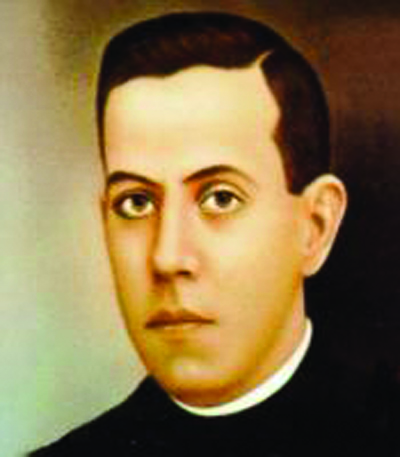
Sister Mariana came to the Philippines in 2000. She is a member of the Hermanas Guadalupanas de la Salle founded in Mexico in 1946 by Brother Juan Fromental Coyroche, a De La Salle Brother from France. The Sisters follow the charism of St John Baptist De La Salle and are involved in the promotion of Christian Education. Their spirituality in the service of God inspires them to look to Our Lady of Guadalupe in her role as evangelizer of the people they serve. They arrived in the Philippines in 1984. Other countries in which they work include Bolivia, Brazil, Colombia, Italy, Madagascar, Peru and Thailand.
Martyr: we have often heard the deep meaning of this word. Witness: to suffer for the God who has kept you alive, and, if required, to give up your life also. The word makes us recall the Witness par excellence: Jesus Christ. The word ‘martyr’ recalls for us the many believers in the early Church who, rather than give up their faith and to show their love, trust and faith in God, faced death.
But here is a modern witness, facing his killers wearing a suit and tie. It’s November 23, 1927, during the religious persecution in Mexico. He is Father Miguel Agustin Pro SJ.
Pursuing his vocation
José Ramon Miguel Agustin Pro Juarez was born on 13 January 1891 in Guadalupe, Mexico, one of 11 children of Don Miguel and Josefa. As a child he had been dangerously ill for a year. Don Miguel held his son before an image of La Virgen de Guadalupe and said, ‘Madre mia, give me back my son.’ Despite not being particularly religious young Miguel found his vocation at 20 and entered the Jesuits despite his fragile health, which meant more suffering. His vocation involved leaving his loving family behind, fleeing to foreign lands, strange languages and customs, as he couldn’t study in Mexico because of the persecution. He studied in the USA, in Nicaragua, Spain and Belgium where he was ordained in 1925.
Father Pro had a number of operations for a bad stomach. He also suffered because of his concern for his family who went through great financial hardship during the persecution. His superiors assigned him to work at home in 1926.
His sense of humor
Returning to Mexico he showed with passion that he understood the words ‘The Good Shepherd lays down his life for his sheep.’ He knew well that any priest found propagating Catholicism could face the death penalty. Many were executed. But we see something really special in Father Pro – his ability to inject into his adventures the cheerfulness that characterized him: one word, one gesture was many times enough to see him escape from the police. In spite of the danger he never lost his sense of humor which he saw as a gift from God. As a child he was musical and a practical joker.
His disguise
Earthly powers weren’t able to stop his priestly zeal. His cheerfulness made him try one and another way of deceiving the detectives assigned to detect violators of the law. He wore many disguises in order to administer the sacraments, celebrate Mass or lead a recollection. There’s a photo of him dressed as a mechanic. On one occasion on his way to anoint an old person he spotted the detectives. A young Catholic woman whom he knew happened to pass by. He linked arms with her and the police thought they were sweethearts.
Persecution of the Church
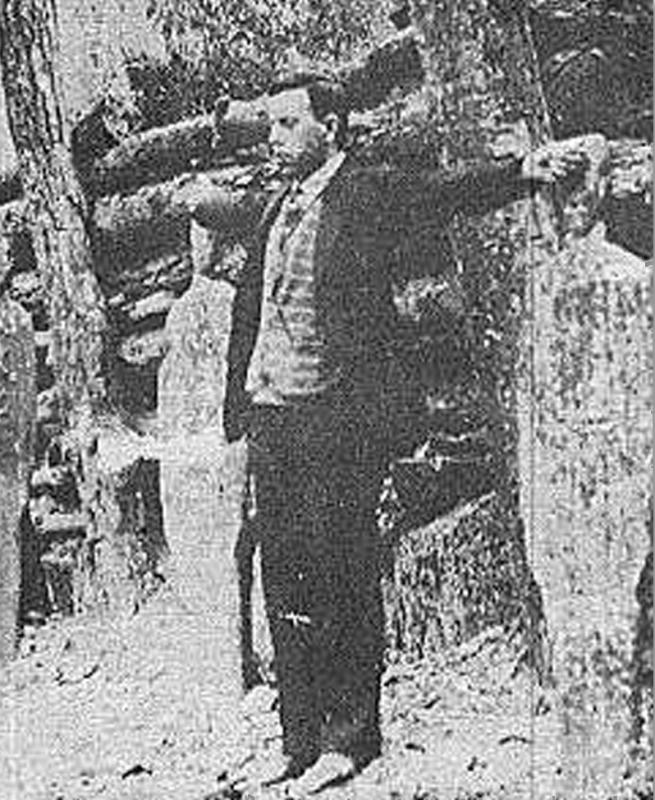
Meantime, the persecution continued. Churches were closed, Catholic schools suppressed, convents expropriated, religious communities persecuted. So many priests, religious, lay persons died. This was Mexico, the land Our Lady visited on 1531 in her apparition to the indigenous St Juan Diego. It seemed that this land had changed its patron. But the blood of martyrs is the seed of new Christians, and the execution of hundreds was not enough to eradicate the Catholic faith from Mexican soil.
Sentenced to death
Now it was the moment Divine Providence destined for Father Pro to bear the supreme testimony of his faith. In November 1927, the authorities arrested Father Pro, along with his brothers Humberto and Roberto. The government authorities linked them to an assassination attempt on the presidential candidate General Álvaro Obregón through an old car that had once belonged to Humberto. (General Obregón had been president from 1920 to 1924 when he was replaced by his ally Plutarco Elías Calles who was the real power. General Obregón was assassinated after being re-elected in 1928.) The authorities were well aware that the brothers were innocent. But because they considered Catholic priests their enemies, the government saw in Padre Miguel and his brothers the perfect scapegoats. Without due process or trial, they sentenced them to death.
The government had a photographer to cover the execution to show up Catholics as cowards. The photos had the opposite effect and later the government made it a crime to possess them.
Martyr’s death
Father Miguel was given a couple of minutes to pray before his execution. He rejected the traditional blindfold and said to the firing squad, ‘May God have mercy on you. May God bless you. Lord, you know that I am innocent. With all my heart I forgive my enemies.’ Serene, he stretched out his arms in the form of a cross, holding a rosary in his left hand, a crucifix in his right. With his last breath he said quietly but clearly, ‘Viva Cristo Rey!’ ‘Long live Christ the King!’ This cry was the assurance that the persecuted and suffering Church of Mexicans was owned by Christ its King.
The testimony of his life
The effect of the news was the opposite to what the government had expected. Thousands turned out for the funeral of Father Miguel and his brother Humberto — Roberto had been released. An old blind woman in the crowd who came to touch his body left with her sight restored. The fervor of the Catholic faithful grew stronger and their fear lessened because of the testimony of the martyrdom of this man of God, this committed priest, selfless in his generous ministry of the Word and the Sacraments; a creative, fun-loving joker, despite his serious demeanor in photos.
Sometime before his death he said to a friend that if he came upon any somber-looking saints in heaven, he’d do the Mexican hat dance to cheer them up. How well he used his gifts to live and die with passion for Christ and his Gospel. May we find in this witness, an inspiration to see that it is possible to live our faith with creativity and face the challenges of modern times in a concrete, loving way.
Bloom Where You Are
by Anabelle B. Gubuan
 I was a fresh graduate from college and eager to land a job. I applied for a part-time job in Misyon magazine. I came to Father Niall’s office for an interview. ‘Don’t worry, I won’t bite you,’ was his greeting to me, aware of the anxiety written on my face. He asked me how many books I’d read in the past five months. When I said, ‘Six,’ he smiled from ear to ear. I was hired. Since then I got addicted to reading even more.
I was a fresh graduate from college and eager to land a job. I applied for a part-time job in Misyon magazine. I came to Father Niall’s office for an interview. ‘Don’t worry, I won’t bite you,’ was his greeting to me, aware of the anxiety written on my face. He asked me how many books I’d read in the past five months. When I said, ‘Six,’ he smiled from ear to ear. I was hired. Since then I got addicted to reading even more.
Father Niall was the only person who encouraged me so endlessly that I didn’t have any choice but to believe him. He kept telling me that I could go further than what I thought I could only reach. When he told me he wanted me to work full-time for the magazine, I knew it was going to be a great privilege working with a person who was always hungry for knowledge and wisdom — and he was always restless until he shared this with everyone.
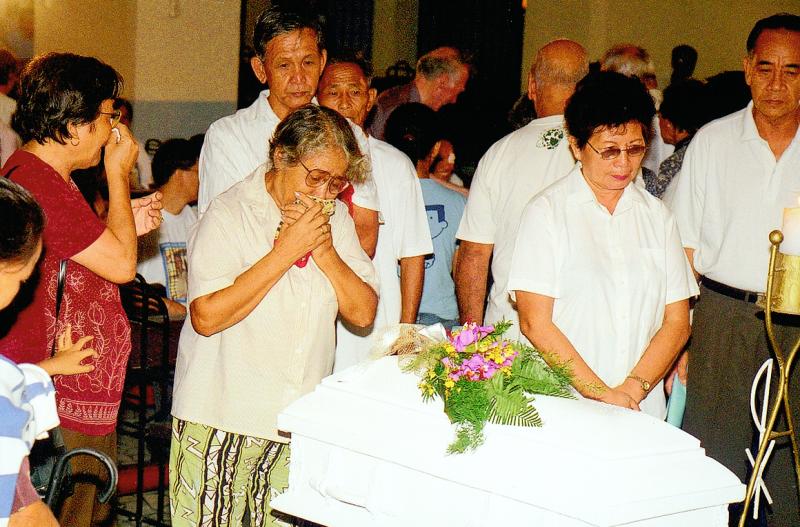
Father Niall touched the lives of many people
He used to call himself a ‘hankering editor’ and, well, he made a ‘hankering’ staff out of us because of that. He trained us ruthlessly, giving us tasks which seemed impossible for us to accomplish, he sent us to all sorts of seminars and workshops. We even weren’t spared from going with him to operas and recitals as well. He believed that in order for us to be fully aware of the things around us, we must go out and experience them. Even when he was already in Ireland for medical treatment, he would update us on the latest movie and insisted that we watch it. ‘You will discover a lot in this movie,’ he’d say and then he would go on in describing the place, the history, the characters.
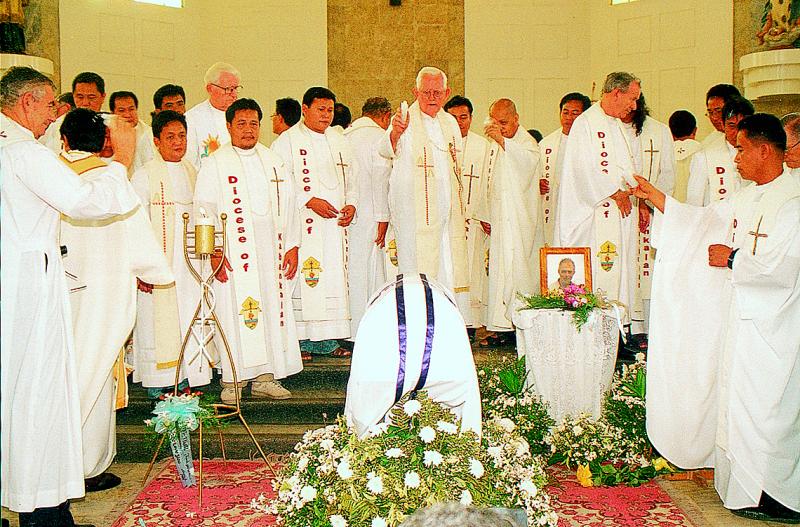
Fellow priest give their final blessing to Father Niall at his funeral Mass
in Kabankalan where he served most of his life
It was through Father Niall that I became so curious about the world and at the same time appreciate every little detail of life around me. I saw how he used to get amazed by a tiny flower sprouting out of the weeds. I always saw myself as that flower, sprouting out from my weeds of insecurities, with Father Niall pulling out each weed that threatened to come out. Now I believe that Father Niall is happily walking in his garden blooming with beautiful flowers.
Father Joeker

By Fr Joseph Panabang SVD

STOP YAWNING
At times, if not all the time, some people keep yawning during the homily. One Sunday, Father Stanislaw Gergont SVD, assistant parish priest of Kintampo, suddenly clapped his hands to get the attention of the sleepyheads and begged, ‘Please, just give me two minutes to finish my homily.’

APOLLO 11
One Sunday I had to wear dark glasses while celebrating Mass. I knew the people were wondering why. The gospel was about the blind Bartimaeus. During the homily I asked, ‘If Jesus were here and asked you, “What do you want me to do for you?” what would you say?’ Answering for myself I said, ‘Please, Lord, heal my “Apollo.”’ Everyone, especially the children, laughed as I removed my dark glasses.
‘Apollo’ is similar to ‘sore eyes’ in the Philippines. Ghanaians named it after Apollo 11, the spacecraft from which Neil Armstrong landed on the moon in 1969. That’s when this infection started in Ghana.

RIGHT ANGLE
I asked one of my altar boys to take pictures. He wasn’t used to taking photos and I noticed that he took a shot of my back. He must have seen my stern look because he came to me apologizing. I told him, ‘It’s okay! That was a good angle. I look more handsome from behind.’ Don’t you agree?
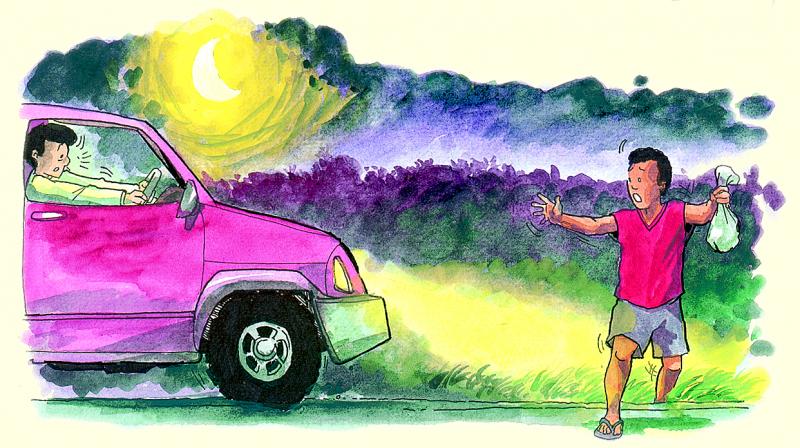
PALM SUNDAY SOUP
I was driving home late in the evening when suddenly I saw our catechist in Nsuhunu desperately trying to stop me on the road. I screeched to a halt, worrying that something had happened. ‘Father,’ he said, ‘please take these palm nuts for your soup tomorrow because it’s Palm Sunday.’ What a relief! It’s a custom for Catholics in Ghana to prepare palm nut soup on Palm Sunday.
From Farmhand To Parish Priest
By Father John Walsh SSC
Columban Father John Walsh tells us of his journey from milking cows on the family farm in New Zealand to being a parish priest in Zambales. He also gives us a glimpse of the pain for himself and his family in this.
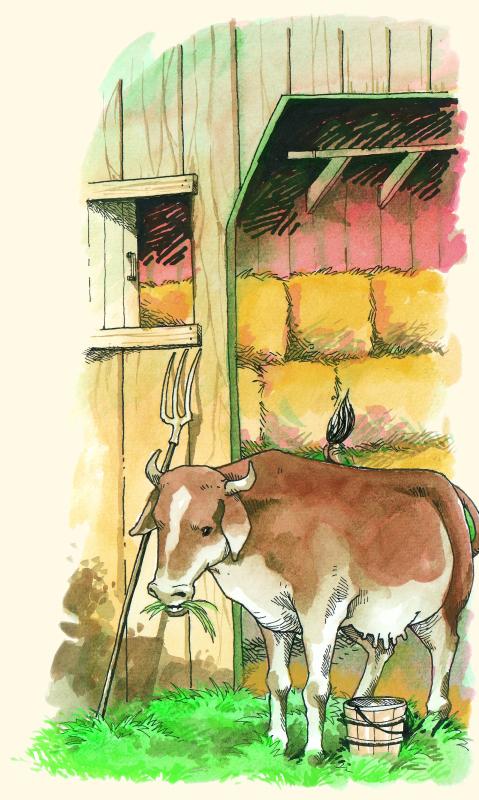
The Columbans first came to Wellington, New Zealand, in 1943 and the following year opened a house of studies for first-year seminarians. The publicity given to this event was the first news our family received that this mission-sending group now had a house in our country. We always knew that they had a seminary over in Melbourne, Australia, because a cousin of ours had been the very first New Zealander ever to go there back in the 1920s.
First aspirant
Without telling any of us, my younger brother, William, wrote to the priest in charge at Wellington to enquire about the procedure for becoming a Columban Missionary. It so happened that our father’s name was also William, so when the reply to my brother’s enquiry arrived, our father quite naturally opened the letter. Now, as the saying goes, ‘the cat was out of the bag’ regarding my brother’s interest in being a missionary priest. However, his health was never robust and he failed the medical test. He changed his mind and went instead to the diocesan seminary, as he really felt called to be a priest.
Then it was me
I was two years older than William and my job was to help my father on the farm by milking cows. My brother’s departure for the seminary in early 1944 made me ask myself seriously if perhaps I too could be doing something different to help God and the Church, apart from milking cows. I went along and had a chat with our parish priest who encouraged me to pray about what missionary priesthood might mean for me as a lifetime commitment.
I did this and then phoned Fr James McGlynn, the Columban in charge at the house near Wellington. Years earlier I had done all my secondary schooling, also near this city. Now I wanted to know what I would need to do in order to enter the following year in 1945. His answer blew me away when he said: ‘But there is no need to wait until next year. Come on down now!’ It seems he knew about me from another Columban who used to live near us.
Sooner than expected
I explained that it wasn’t quite that easy; that I would need to speak with my father because of the cows. Making such an arrangement proved to be a minor problem. The big hurdle was my mother who said she would be very happy for me to be a priest, as long as it was in New Zealand! I convinced her that leaving to live abroad was a long way off and at the moment all I wanted was her blessing on my going down to Wellington.
I started the road
This I did in Holy Week in early March and found myself with two others who had arrived a couple of weeks earlier for the first year of training. This was mainly a lightly-structured time with an emphasis on spiritual formation that included, apart from chapel activities, studying the life of Christ, some classes in Latin and also a very useful daily period given to memory training. We also did a 30-day retreat. Our chances for sport were limited since there were only three of us, so we did a lot of walking together and also worked in the spacious grounds and gardens of the property.
Happy to go
As of 1945 the rest of my studies were done near Melbourne. World War II had just ended and as regular shipping was not yet back to normal it was impossible for us to travel to Ireland for our study of theology in the Columban seminary there, which had always been the pre-war practice. So we went to the nearby diocesan seminary and that was our home for the next four years until ordination in 1950. The three of us who had begun in 1944 were now just two, Father John Griffin and myself, and we were both delighted and excited to receive our missionary assignment in October 1950 – the Philippines!
We finished our studies, had a holiday with our families while awaiting our transport and then sailed off on a slow cargo boat to Manila, knowing that it would be 1958 before we would be due for home leave. We arrived in May 1951 and learned that the Columbans had just undertaken a new mission in Zambales so both of us were added to their number.
The most difficult price
Later that same year, 1951, my younger brother was ordained back in New Zealand but sadly I never saw him as a priest. A fatal illness had been with him for most of his seminary days and he died in 1954. I attended neither his ordination nor his funeral. Nor was I able to be there when my mother died in 1956. My absence from these family events was the most difficult price that God ever asked me to pay for my missionary priesthood. That was fifty years ago and of course things are much different nowadays, especially in regard to Columbans and home leave.
During 54 years of priesthood I’ve had various assignments in Zambales, in Australia and back to Zambales. Finally in 2000 I returned to New Zealand to live out my days – back on the same property where I began my life as a Columban sixty years ago.
I have an endless supply of happy memories to occupy me and so many reasons for offering thanks to God. Chief among these is the good supply of local Filipino priests and the fact that our Diocese of Iba, Zambales, no longer needs the help of the Columbans. This is the goal we were always working towards and when the time came for me and others to return to our homelands, it was with a sense of ‘mission accomplished.’ Earlier missionaries before us, notably Augustinians and SVDs, had tilled and watered and we, under Columban Bishop Henry Byrne, planted. Today God gives a good harvest of vocations. Praise him!
Father John Walsh briefly mentions his pain in not being able to attend the ordination of his brother and the funerals of the same brother and of their mother. His experience echoes that of St Paul as he left Ephesus. After this discourse, Paul knelt down with them and prayed. Then they all began to weep and threw their arms around him and kissed him. They were deeply distressed because he had said they would never see him again. And they went with him even to the ship.
(Acts 20: 36-38 Christian Community Bible translation)
I Will Always Remember You
By Gee-Gee O. Torres
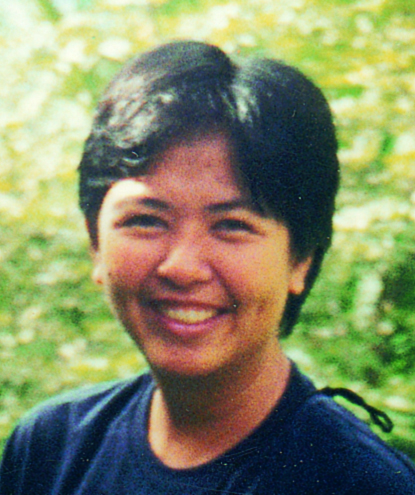 I’d worked with Father Niall in Misyon for almost nine years, but why do I find this very difficult to write? There’s so much to tell about him but I don’t know how to begin. I refuse to think that he’s not with us anymore. I am afraid that if I do, he’d be part of yesterday and it would mean that he would become someone to remember only once in a while — I don’t want that. If I could only hold back the time, I would. I’d like April 23 of this year to last forever. This was the day when he sent me his last email. He told me that he was looking forward to Tuesday because they were going to do an ultrasound on him. He said that things were looking brighter though there was still a long way to go. This gave me high hopes that he’d make it and that I’d see him again. However, April 25 we received the news that he had a bad fall from his wheelchair, then April 27 his sudden death. I felt empty . . .
I’d worked with Father Niall in Misyon for almost nine years, but why do I find this very difficult to write? There’s so much to tell about him but I don’t know how to begin. I refuse to think that he’s not with us anymore. I am afraid that if I do, he’d be part of yesterday and it would mean that he would become someone to remember only once in a while — I don’t want that. If I could only hold back the time, I would. I’d like April 23 of this year to last forever. This was the day when he sent me his last email. He told me that he was looking forward to Tuesday because they were going to do an ultrasound on him. He said that things were looking brighter though there was still a long way to go. This gave me high hopes that he’d make it and that I’d see him again. However, April 25 we received the news that he had a bad fall from his wheelchair, then April 27 his sudden death. I felt empty . . .
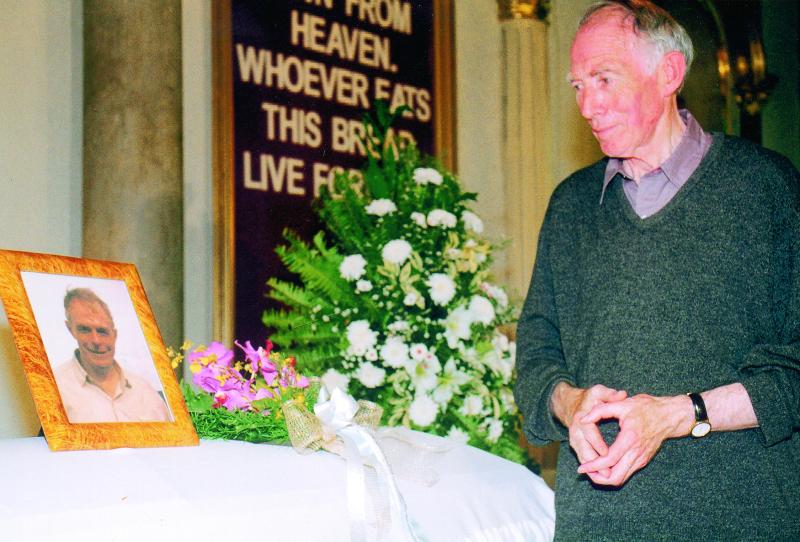
The eldest brother of Father Niall, Fergus, brought home his ashes to the Philippines
Father Niall was not just an editor to me. He was a friend — a friend whom I could talk to, a friend who listened. He told me to remember the story of the Three Wise Men . . . ‘they were following the Star and then it disappeared. But the important thing is that they kept going and then suddenly the Star reappeared right over the place where the Infant was in the cave . . . that will happen to you. The clouds will lift and the Star will reappear and you will be flooded with happiness and you will remember my words.’
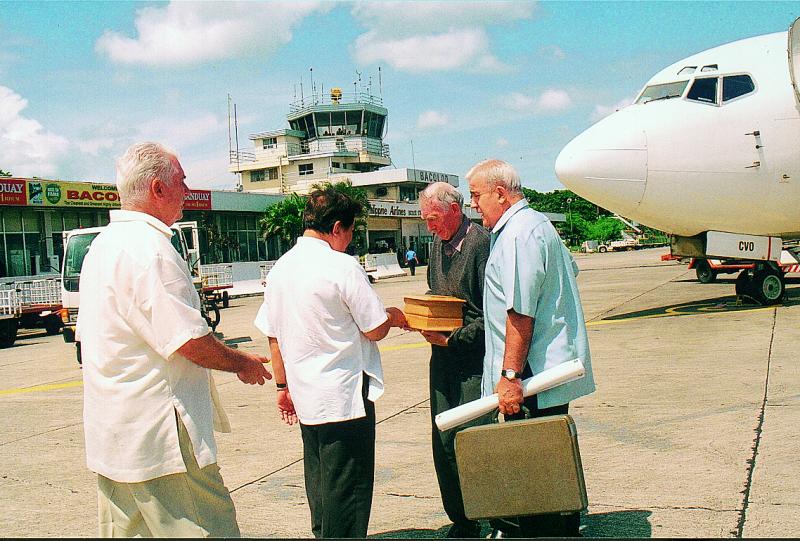
Fergus hands over the urn to Msgr Vic Rivas (Diocese of Bacolod)
Father Niall, I will always remember your words. You know how much you touched my life and how grateful I am for all the things that you taught me. You taught me how to live and showed me how beautiful life is. You will always have a special place in my heart.
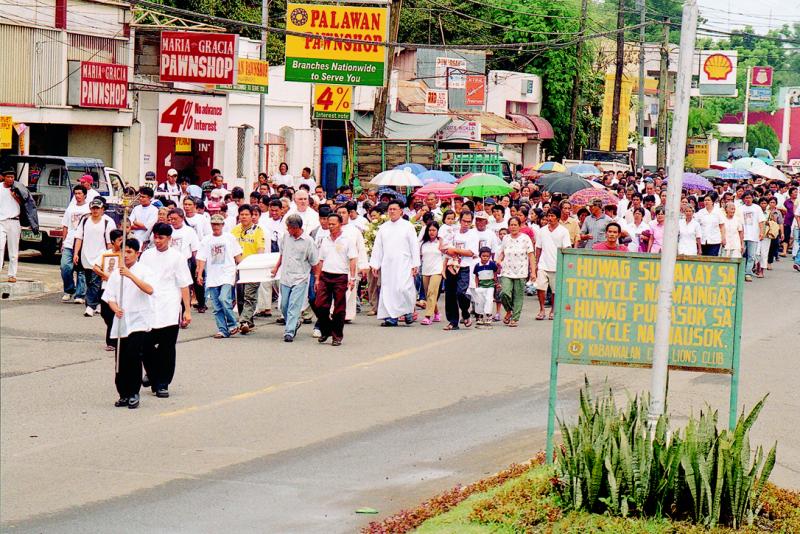
Father Niall's parishiners in Kabankalan took turns in carrying the casket containing his ashes
Life On The Mountaintop
By Sister Maria Luisa Tomaro OND
Moving from a small island to a mountainous area is not without its difficulties, as Sister Maria Luisa knows only too well.
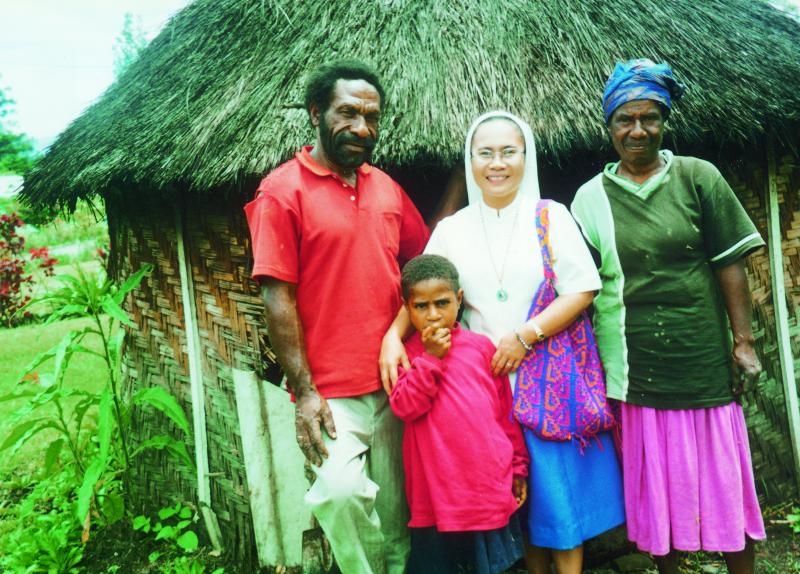
Reading Misyon regularly encouraged me to share my mountain experience here in the Diocese of Daru-Kiunga, Western Province, PNG. I was in Daru Island before but we closed our mission there so I was transferred to the mountain of Golgobip, a different experience with different people in a different place and situation. In Daru, I was surrounded by the ocean but now am surrounded by high mountains without roads and cars. The only means of transportation is the plane. If it doesn’t come because of bad weather or no passengers from the center we, my sister companion and our parish priest, are stranded and have no food to eat except kau-kau and taru (kamote and gabi), the people’s staple food. Anyway, by God’s grace we survive.
Their Ritual
We had the blessing of a church by Bishop Gilles Côté SMM and other visitors from Daru. The people planned to kill three pigs. A day before the blessing I wondered as I saw three posts in front of the new church. The following morning I saw a pig tied to each post. Suddenly three men wearing traditional dress with bows and arrows went outside the church. They sang and danced around the pigs. People came to witness the ritual and the three men slowly shooting the pigs with their bows and arrows so that the pigs’ blood spread out in front of the church.
I asked what it meant. I learned that the ritual killing of the pigs, used for blessings and big feasts, is an expression of thanksgiving to God by the people for all the graces they have received, offering the best that they have. For them, pigs are very precious animals. Piglets stay in the people’s houses until they grow up, sleeping under the same roof.

Enough for All
After Mass the people gathered together to cook a special dish of vegetables and pork. When the food was ready, they divided and shared it by clan, a ‘multiplication of food’ in which all had enough to eat.
Despite my injury
In the afternoon Bishop Côté and myself with some leaders left the place to go to another village for Confirmation. We walked on the rocky high mountain where there was no clear path. Unluckily, before we reached the village, I slid down and badly injured my left hand. Pain reliever helped me sleep that night. The following morning we walked again to another village, a journey of eight hours. I don’t know how I managed but I felt no pain in my swollen hand. The healing touch of God must have been working in me. I reached the place with joyful perseverance and a feeling of victory because I made it.
Mountains after mountains
After three months, I went again with our parish priest and his assistant to visit the villages and give seminars. This time I was very careful to avoid accidents. We left at 9am the first day and reached our destination at 8pm. While walking I was struggling because both my feet were sore. I could hardly climb the rocky mountains with the pain and tiredness. But I had to be strong and courageous. Thank God, we reached the place safely without any accidents.
There are still many villages waiting for me. Some take days to reach on foot. But I can’t say no to walking. There’s no other means of travel. Besides, I want to discover more the people’s practices and beliefs and to learn from the simplicity of their lifestyle. Their faith is deeply rooted in God. No matter how difficult life is they still have time to worship God.
Singing amidst hardship
In spite of these difficulties encountered on the foreign mission the flame in my heart still continues to burn. Silently, my heart always sings, ‘To love the Lord our God is the heartbeat of our mission, the spring from which our service overflows.’ I pray that God will continue to inspire me so that I will not be tired of singing. This song inspires me every time I climb a mountain.
Life-giving moments . . .
By Rosemary Taker
Rosemary Taker, from Merseyside, the region in North West England that includes Liverpool, the home of the Beatles, recently returned there after three years as a Columban lay missionary working in Sinacaban, Misamis Occidental, in the Archdiocese of Ozamiz. Here she shares her reflections before leaving Mindanao.
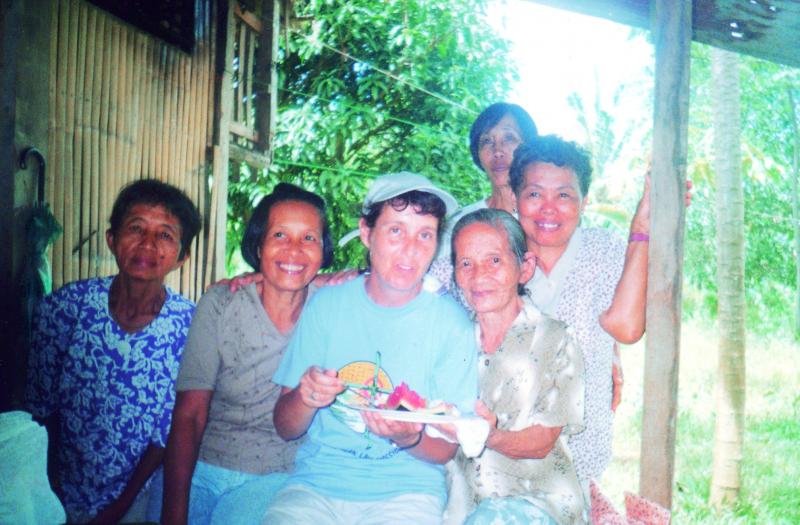
I worked with children and families in Britain as a social worker before becoming a Columban lay missionary. After three years in the Philippines I look at things from a different perspective. I feel privileged to have journeyed with the people who, despite their struggles, pain and hardships, always find the time to smile. Being here has not been without difficulties and challenges, but becoming vulnerable and powerless has brought me closer to God and strengthened my prayer life.
A different kind of richness
Living here with people whose acceptance overwhelms me has been life-giving and a blessing. Living simply in my one-roomed house, cooking outside, and having to fetch water daily from the well, has made me realize how much I took for granted in my western world. But as time has gone by it has also made me think that material things are not so important, but that being rich in spirit is. I see this in the people around me, so rich in spirit in their kindness, smiles and friendship.
Friends’ I’ve gained
Visiting the people daily, especially those on the margins, has opened my eyes to their lives. I’ve found so many loving and accepting people in Sinacaban who took the time to be my friend and who welcomed me into their homes. Norma and her niece Empoy, who knew nothing about me, willingly took me into their home to live there. ‘Knock and the door will be opened; seek and you will find.’ I lived with them for a few months before moving to my own little house nearby. It was a real heartbreak for me when Empoy was drowned, aged only 11, as I had grown to love her as one my own family.
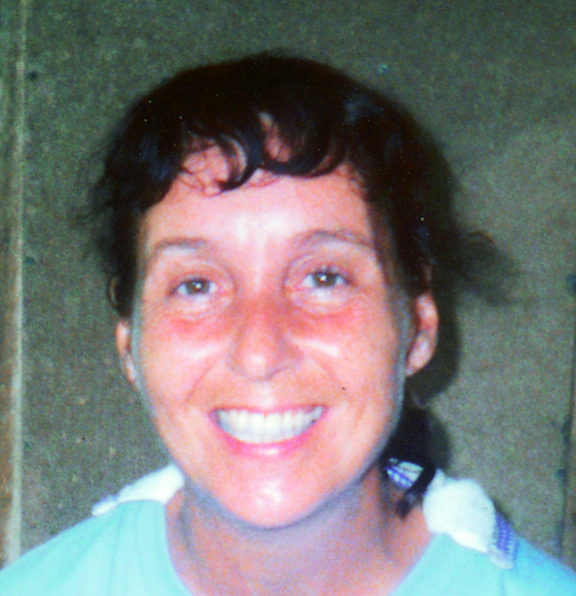
Others too touched my life
Mylene has a physical disability but her courage and determination overwhelm me. She was born into a family of five sisters and three brothers. She had polio when 4 and the possibility of her ever walking again was nil. She remembers when a small child her mother regularly burying her in the warm sand to get her blood circulating. At that stage she was paralyzed and could only move her eyes. Mylene still has a disability but is mobile with help. She is one of the most courageous women I’ve ever met, with extraordinary strength, determination and, most of all, trust in God. She’s married now with two adopted children. She has had many other hardships in her life. Her father died from cancer when she was young and when Mylene was 13 her mother was murdered. She remembers Martial Law in the 70s and 80s when people had no freedom of speech in the Philippines. Difficult times.
Self-discoveries
In Sinacaban I’ve learned such simple things as how to cook rice properly and wash my clothes with the women at the well. I’ve found many life-giving moments among the people and children here and have learned much about my weaknesses and strengths. There have also been many times of isolation and loneliness as I struggled to learn a new language and culture. Despite the difficulties of isolation from my family and friends back home, the people kept me going. The life-giving moments have outweighed the down moments, especially when I visited the people, ate, shared and laughed with them or joined them in prayer at the holy hour in the local church.
Simple reality
I looked forward to women coming to my house for coffee or to share a meal. Celia, a regular visitor, shared her stories and introduced me to many people. Nida loves to dance and sing. The ever hospitable Teryang is 70 plus but has so much faith and believes that the answer to life’s problems is to pray and always trust in God. As I struggled with the language the people were always there to assist and encourage me for trying. This strengthened my faith and trust in God and made me appreciate the simple reality of just being with people and journeying with them.
As I prepare to end my term here I don’t know what my next plan is or where God will lead me. I’m looking forward to seeing my family and friends back home but will carry in my heart the people I’ve met here in the Philippines.
Mother Teresa In Her Own Words
There are some people who, in order not to pray, use as an excuse the fact that life is so hectic that it prevents them from praying. This cannot be. Prayer does not demand that we interrupt our work, but that we continue working as if it were a prayer.
It is not necessary to always be meditating, nor to consciously experience the sensation that we are talking to God, no matter how nice this would be. What matters is being with him, living in him, in his will. To love with a pure heart, to love everybody, especially to love the poor, is a twenty-four-hour prayer.
The first requirement for prayer is silence. People of prayer are people of silence. Silence will teach us a lot. It will teach us to speak with Christ and to speak joyfully to our brothers and sisters.
Prayer makes your heart bigger, until it is capable of containing the gift of God himself.
Prayer is not asking. Prayer is putting oneself in the hands of God, at his disposition, and listening to his voice in the depths of our hearts.
Praying the Our Father and living it will lead us to saintliness. The Our Father contains everything: God, ourselves, our neighbors . . .
Prayer begets faith, faith begets love, and love begets service on behalf of the poor.
This is a prayer that the
Missionaries of Charity pray everyday.
Cardinal Newman wrote it:
Jesus, help me to spread your fragrance
wherever I am.
Fill my heart with your Spirit and your life.
Penetrate my being and take such hold of me
that my life becomes a radiation
of your own life.
Give your light through me and remain in me
in such a way that every soul
I come in contact with
can feel your presence in me.
May people not see me, but see you in me.
Remain in me, so that I shine with your light,
and may others be illuminated by my light.
All light will come from you, Oh Jesus,
Not even the smallest ray of light will be mine.
You will illuminate others through me.
Place on my lips your greatest praise,
illuminating others around me.
May I preach you with actions
more than with words, with the example of my actions,
with the visible light of the love
that comes from you to my heart. Amen.
Our Hideaway

Life and Death
Have you ever wondered what it would be like spending life with the dead and yet being unafraid?
Friend to the mourners

I know a man who lives just like that most of the time. His name is Kalis. He’s a friend to embalmers, to those who arrange flowers for funerals and to newly-bereaved families. His town folks know him well even though he’s seldom seen on festive occasions such as weddings and birthdays. Ask anyone where he is and the answer will always be the same: ‘Kung saan merong patay, siguradong nandoon yan!’ And what is he doing? Chances are, you’ll find him helping the mourning family, doing errands, teasing the teenage boys or being teased by them, talking about things that would make your head spin in confusion and making you laugh. Kalis, who has a mental disability, could drive you crazy at times.
He has no permanent address but makes his temporary home in a house where someone has just died. At funerals he’s the one who leads the procession to the church. He helps carry the coffin, instructs others to go this way or that, as if he’s the boss. But people respect him and follow him till they reach the cemetery. When things settle down in the family of the dead, he’s nowhere to be found. The next time you hear of someone dying in his hometown, no doubt Kalis will be there, repeating the same thing.
He truly is a special person, with a mental disability, yet beautifully equipped with helping hands and a loving heart. He uses these in his unique way which undoubtedly pleases God. Since life on earth has to end, like us, he too will perish. Death then will not be the end of everything but the beginning of another life for him. His good deeds and his innocence are his passport to heaven.
Our unique gifts
If we follow his extraordinary example, we too will enter God’s Kingdom. But it is not necessary for us to be ‘different’ and carry a coffin just to enter heaven. God has endowed each of us with many talents. No one is not gifted. Everybody in different ways is capable of great things. The words of Bishop Thomas Ken challenge us: ‘Teach me how to live, that I may dread the grave as little as my bed.’
The Dead Were Buried But Life Continues
By Sister Josephine Ong ICM
Burundi, a former Belgian colony, is a landlocked country in central Africa with an area of 27,830 sq kms, just over a quarter of the size of Luzon. 62 percent of its 6,223,897 people (July 2001 estimate) are Catholics. 85 percent are ethnically Hutus and 14 percent Tutsis. Inter-ethnic conflict has broken out a number of times and at least 200,000 died in a civil war that lasted from1993 into 2000. Trouble broke out again last year, as Sister Josephine writes.
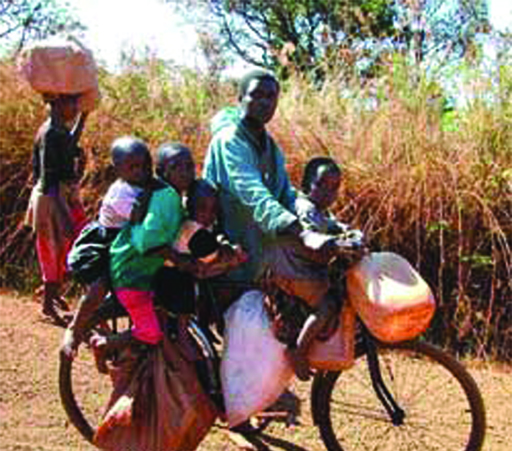
On 5 July 2003 five new priests were ordained in our diocese in a beautiful ceremony that lasted nearly six hours. These were the first ordinations at Our Lady’s shrine, north of the city proper of Bujumbura, the capital. About a thousand attended the agape. And can you imagine nine choirs? It was impressive how all the parishes and the reception committee put their hands together to make this day memorable.
After a beautiful day
That was Saturday. At 3am on Monday bombings began, the start of a battle between the army and the so-called rebels that lasted till the 13th. During daytime helicopters bombed the battle area. However the sight of this didn’t prevent us from going back to work. Everyday in retaliation the rebels fired missiles at particular and varied targets that included a bank, a hospital, a place near the cathedral, a pharmacy, a nightclub and some private homes. A bomb fell close to the modern church at Our Lady’s shrine. Happily, nobody was hit. But we didn’t know how many lives were lost at the battle site. On TV we saw houses that were hit hard. Among the rebels that fell were boys between 12 and 15, horrible!
Calm after the storm
The 13th was also terrible because the battle got closer to where we live. I stayed put in bed wondering which part of the roof would be hit. Saying my rosary at the start was impossible, for I was shaking in bed. That took me 10 to 15 minutes. The battle lasted from 3am to about 10am. It was impossible to go to the church close by because the streets were blocked by the military. So we had to go farther out to the west side were it was calm and the parishioners were not bothered at all. On that same morning there was a fiesta in a parish further out for the blessing of its new church. At noon our vicinity was back to normal, thank God!
Restoration
The dead were buried and life continued. Teams of health workers quickly rescued survivors. The seminary and the museum hosted many people during that week, likewise the shrine of Our Lady. Houses were reconstructed with government aid. Slowly the displaced went home where there was still a roof and remained constantly trusting in God’s providential care.
The Road Less Taken
By Gee-Gee O. Torres
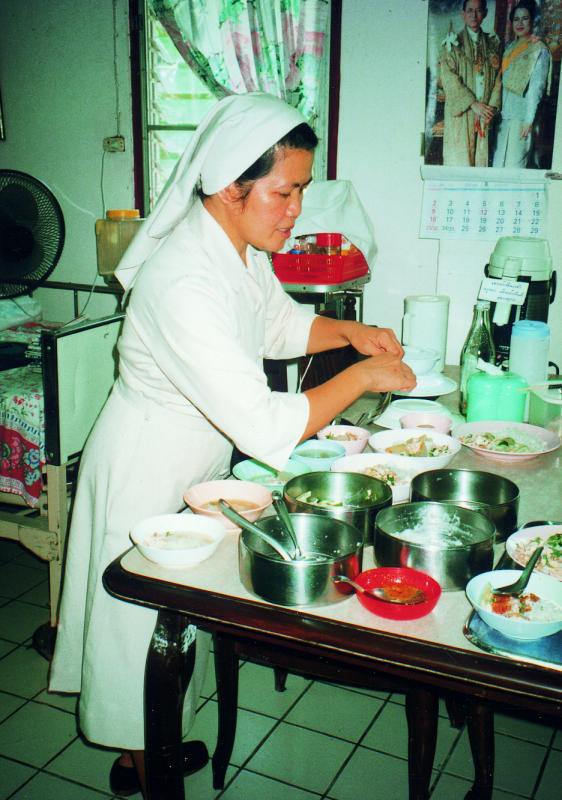
I went to visit our Filipino missionaries in Thailand in 1998. There I met Sr Angela San Jose of the Daughters of Charity. At that time she was assigned to St Clare’s Hospice in Pathumthani, a hospice for AIDS patients who are in the last stages of AIDS. It was founded by the Franciscan Friars in response to the great need to care for poor and homeless persons with AIDS. Today Sr Angela is assigned to Laos. Below I share with you my visit to her.
As I write this article, it’s almost six years since I visited Sr Angela in Thailand. It’s been quite a long time, but how could I forget her? Finding her ‘sanctuary’ was one of my unforgettable experiences when I visited our Filipino missionaries there.
Father Leo Ochoa SDB, my tour guide, accompanied me to almost all of the mission stations I visited. However when it was time to visit Sr Angela he could not go with me so he asked one of his staff, Nui, instead. Father Leo assured me that we would be okay. He must have sensed my anxiety, knowing that I was not familiar with the place. We left his office at 4 pm, took the bus and off we went. I didn’t have any idea how long the trip was going to take. I trusted Nui knew where St Clare’s Hospice was. Father Leo gave her the directions. I didn’t understand their conversation since they were talking in Thai. I just caught the words “about two hours”.
The bus ride

I sat quietly in the bus, enjoying the view especially the scenery outside the city. However when the passengers on the bus got fewer and fewer, I began to feel uneasy and nervous. It was already dark, almost 8pm. Eventually Nui stopped the bus and we got off. I felt relieved thinking that we had reached our destination. But I was mistaken. Nui didn’t know exactly where St Clare’s Hospice was. I could see the worry in her eyes while she was asking for directions from the few people around.
Travelling with a stranger
We were both hungry. We saw a carinderia and went in. Unfortunately they were already closing. Good thing there was still some chicken mami left for us to take out. Then a young man approached us. He said he could bring us to the hospice. I was suspicious, but I didn’t have the chance to tell Nui because she took me by surprise when she told me right away to ride the motorbike — the two of us. The driver said it was just nearby, but it seemed like eternity to me. It was taking us more than 30 minutes already on rough roads and here we were on a motorbike with a stranger. We were passing through field after field. There weren’t any houses at all. I saw some flickering lights from a distance. I told myself not to be afraid anymore because the lights meant that there were people living in the area. But still I surrendered my life to God and prayed, ‘Thy will be done!’
Arrival at the hospice
The motorbike stopped in front of a gate. Finally we had reached our destination. I wanted to jump with joy. We thanked the young man and he left. We called out – several times – but no one answered. We began to panic. We tried calling Father Leo on his cellphone but to no avail. Then a priest came out. With a puzzled look, he asked us for our purpose. He must have been surprised to find two young ladies on his doorstep at this unholy hour. I told him that we were looking for Sr Angela and that we arrived late because we got lost. I thought we would have to sleep outside because he seemed hesitant. But he did offer us a room! He said we could see Sr Angela the next day since she must be asleep already at the hospice. We stayed in their guest room. Nui and I were very tired; we immediately settled our things in the room and without much ado took out the chicken mami we bought from the carinderia. We didn’t have any utensils so you can just imagine how we struggled to eat the noodles.
No wonder
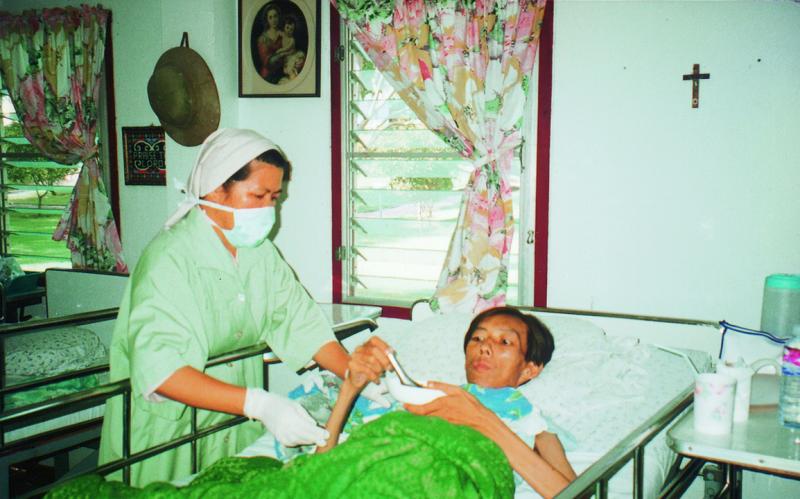
The next day Nui and I shared with Sr Angela our exciting trip. She smiled and told us that, aside from our getting lost, we traveled 60 kms northeast of Bangkok and since we left Bangkok at the rush hour, we got caught in the traffic. No wonder it took us forever to reach the hospice!
Sr Angela showed me around. I was surprised to find the hospice surrounded by a beautiful garden. I imagined it to be just an ordinary building with rooms for patients. But the flowers in the garden made the place bloom with hope and happiness. When we were about to enter the hospice, Sister asked me if I was ready to meet the patients. I said Yes, even though I was quite apprehensive because this was my first time to meet AIDS patients. She introduced me to them and they welcomed me with their timid smiles. It was time for Sister to prepare their food and their medicines, so she excused herself. I walked around and quietly observed the volunteers attending to the patients. I marveled at their sincerity and commitment in helping the Sisters in their work.
A better world
There is still no cure for AIDS. This epidemic continues to spread throughout the world. AIDS victims are neglected by the society, leaving them to die in misery. However, with people like Sr Angela who are truly dedicated in caring for these people, this world becomes a better place to live in.
I left the hospice with a smile on my face. The long, tiring and tense journey was all worth it. I knew that the patients who welcomed me with their timid smiles would not be left to die alone in misery because they were living in a home with people happy to care for them.
The Vanishing Tree
Father ‘Bong’ Suñaz, now back in the Philippines after serving in East Timor, tells us of the decline of the sandalwood tree in that country before it became independent of Indonesia in 2002.
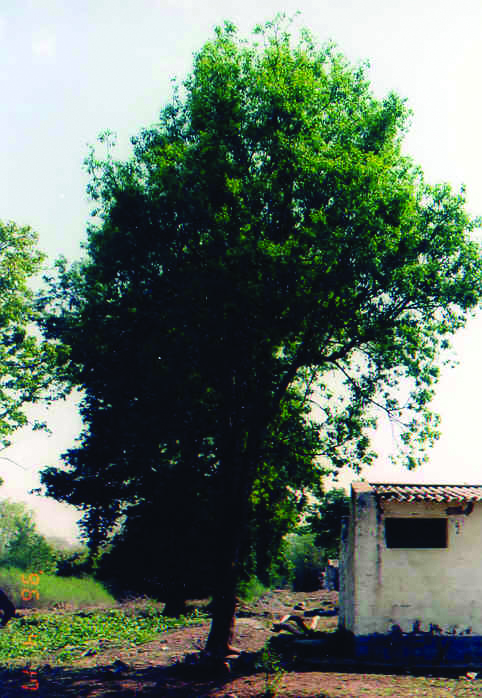
I remember a beautiful song entitled SANDALWOOD in catechism class back in Manila two decades ago. I still hum it sometimes now and I realize that the place mentioned in that song is the island of Timor, or so I think. I once had the chance to talk about the tree with the head of the Department of Forestry and he said that in Timor the sandalwood tree grows wild, unlike in India and China real plantations were created for economical reasons. He said that most probably during the colonial times of the Portuguese, seedlings of this tree were brought to Goad in Macao hundreds of years before which were also under the colonial Portugal. The tree grows both in the East and West Timor. It is called Cami in Tetun, the local language of Cendana, in Bahasa, Indonesia.
Fragrant baul
Can you remember the ‘baul’ that your lola kept in the ‘bodega’? It smells terrific, right? Well, that is sandalwood. Sandalwood is a small tree that grows as much as 9 meters only. When it reaches the mature age of 30 years the core of the wood smells like a fine perfume. The tree grows mostly on rocky grounds and it seems not to like water very much. There are two kinds of sandalwood: the reddish core and the plain white or mil color. The bark of the tree doesn’t smell like the leaves. Nor the newly cut trees. It is when it is dry that the wood, especially the core of the trunk, is really fragrant.
Government possession
Under the Indonesian government the harvest of the wood is monopolized by a government corporation. No one is allowed to use the wood for any personal profit, not even as decorations. Thus if you have the tree in your garden or in your field you still have the obligation to get government permission to make use of it. You are only allowed to sell it to the government.
Fast disappearing
The roots of this tree are capable of regrowing itself. There is a very little effort done for replanting. This is one of those rare plants that grow by symbiosis. It is difficult to grow them. It needs a lot of attention in the first two years of its growth process. The precious trees are fast disappearing. First, no one is interested to plant it since it takes long years before it could be harvested. Secondly selling it to the government you receive only a token since it is considered as one of the natural resources of the country. Thirdly, those that grow in the wild are systematically harvested by the government.
Harvest time
At certain time of the year especially during the dry season, the governor will give the order to the mayors of the different towns to harvest the wood. The mayor in turn will give the order to the Barrio Captains who will in turn order the head of the different zones under him. These people will order all the people of the place to search in the mountains for the wood. For each kilo they bring in they are only paid a token, an equivalent of six pesos.
Sandalwood
Most of the local products that are produced from this wood by the government company are: pure perfume oil in little bottles, lady fans, beads for rosaries and other little products for souvenirs. The chief use of the wood is for exporting as raw materials for perfume, soap and medicines.
‘Our Father’ In Melanesian Pidgin
Papua New Guinea has more than 5,000,000 people and 715 indigenous languages.
Melanesian Pidgin, known also as ‘Tok Pisin,’ is widely used as a lingua franca o common language. Below is the Lord’s Prayer in that language. See how many English words you can find. You can find out more about Pidgin languages at:
Papa bilong mipela, yu stap long heven.
Ol i santuim nem bilong yu.
Kingdom bilong yu i kam.
Ol i harim tok bilong yu long graun olsem long heven.
Tude givim kaikai bilong de long mipela.
Pogivim rong bilong mipela,
olsem mipela pogivim rong ol i mekim long mipela.
Yu no bringim mipela long traim,
tekewe samting nogut long mipela.
Amen.